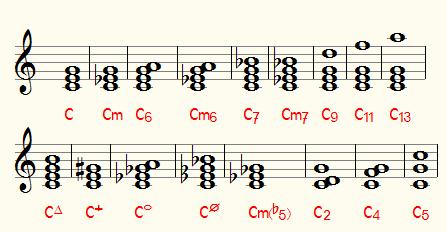Chord symbols
Chord symbols provide information about the chords (harmony) to be played in a piece of music. Different chord notation systems are used depending on the country, instrument and music style. MusiCAD internally uses the Anglo-American system.
In MusiCAD chord symbols must be entered at the main part (in the score dialog marked with underline). If chord symbols are listed in a part other than the main part, they have no effect when creating automatic parts.
The note at which the chord symbol is notated determines when that chord is to be played and how an accompaniment part will be created from those chord symbols.
The placement (below or above the part) and font (size, color) of chord symbols can be specified under the text type data of chords in the text format menu.
| <u> | Change chord symbol at cursor position. |
| <a> <b> <c> <d> <e> <f> <g> | Set chord symbol to note at cursor position (provided text select is set to chord symbols). The chord starts with the letter entered (in capital letters). If the cursor is on an existing chord, it will be replaced. |
| <alt-shift-N> <alt-ctrl-N> | To instruct MusiCAD to stop the automatic accompaniment parts at a certain point, use a special 'chord': a - sign or NC (No Chord). You enter such a 'silence chord' (tacet) by converting an ordinary chord symbol into an 'NC' chord. |
Also text files (lyrics) that contain chord symbols can be displayed, edited and transpose with MusiCAD.
For notation of diphthongs and polyphonics under symbols see chords.
For stringed instruments that need chord diagrams (tabs, guitar chords like ![]() ) you can enter in [Part properties|Chord diagrams] the desired instrument code (git,ukelele etc.) as used in the selected [Preferences|Files|Chord diagram list].
) you can enter in [Part properties|Chord diagrams] the desired instrument code (git,ukelele etc.) as used in the selected [Preferences|Files|Chord diagram list].
Input of chord symbols depends on the text input mode, but can also be done with the chord wizard.
The list below shows the chord symbols interpreted by MusiCAD:
| Internal | Alternative | Structure | Description |
|---|---|---|---|
| C | Cma | 1 3 5 | C major (major) |
| Cm | C- / Cm | 1 3b 5 | C minor (minor) |
| C2 | Csus2 | 1 2 5 | C with second instead of third (suspended 2nd) |
| C4 | Csus4 / Csus | 1 4 5 | C with fourth instead of third (suspended 4th) |
| C5 | 1 5 8 | C with omitted third ('power chord') | |
| C6 | 1 3 5 6 | C major with added sixth (added 6th) | |
| Cm6 | C-6 / Cmi6 | 1 3b 5 6 | C minor with added sixth (minor add 6th) |
| C7 | 1 3 5 7b | C (dominant) seventh (7th) | |
| Cm7 | C-7 / Cmi7 | 1 3b 5 7b | C minor seventh (minor 7th) |
| C^ | CΔ / CM7 / CMaj7 | 1 3 5 7 | C major seventh (major 7th) |
| Cm^ | CmΔ / CmM7 / CmMaj7 | 1 3b 5 7 | C minor major seventh |
| C9 | 1 3 5 9 | C major with added ninth | |
| C9b | C(b9) | 1 3 5 9b | C major with added minor ninth |
| C11 | 1 3 5 11 | C major with added 11 | |
| C13 | 1 3 5 13 | C major with added 13 | |
| Co | Co / Cdim / Cdim7 | 1 3b 5b 6 | Diminished C chord (diminished, dim) |
| C0 | CØ / Cm7(5b) | 1 3b 5b 7b | Half diminished C chord |
| C+ | C+ / Caug / C(5#) | 1 3 5# | C-augmented |
| C# | C sharp major | ||
| Cb | C-sharp major (b is a flat) | ||
| C9/h | C-none with B as bass note (h for note letter lowercase b) | ||
| C9#11 | C-none with raised 11 | ||
| C9b11 | C-none with lowered 11 |

